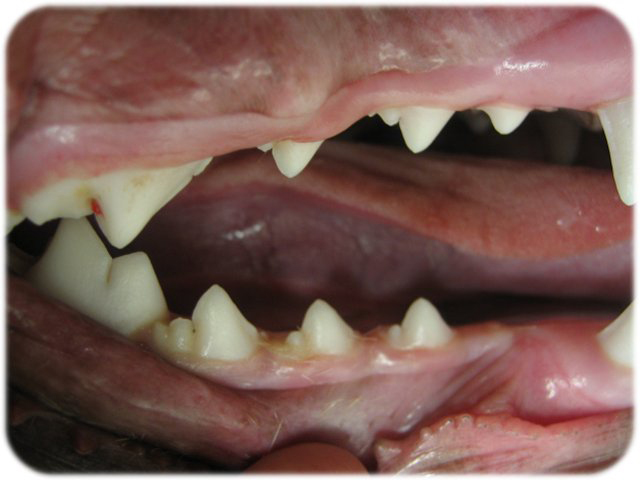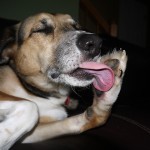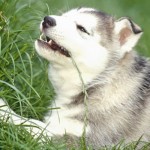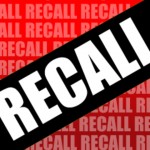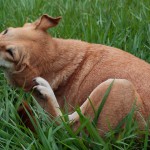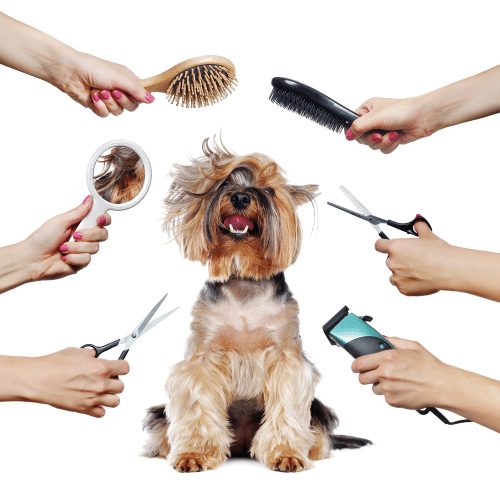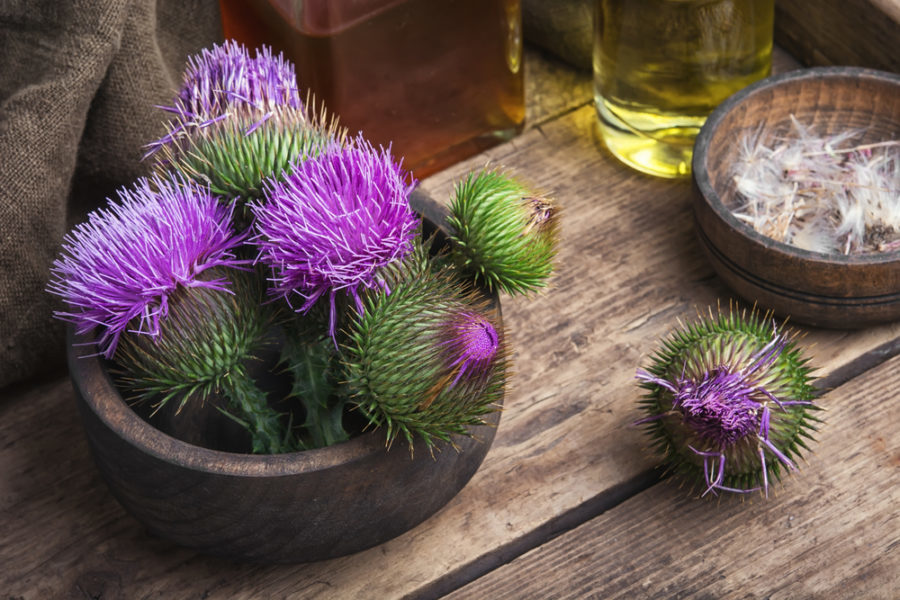Are your dog’s teeth shiny white?
Most dogs’ teeth aren’t.
According to Dr Brooke Niemiec of the American Veterinary Dental College, dental disease is the number one medical problem among pets today!
In fact, over 70 percent of dogs and cats will suffer periodontal disease by the age of two.
Dental Disease Affects More Than Your Dog’s Mouth
Studies have linked periodontal disease in both humans and pets to systemic diseases of the kidneys and liver, heart disease, lung disease, diabetes complications, problems during pregnancy, and even cancer.
According to holistic veterinarian Karen Becker (who is also a conventional veterinarian):
“These serious health concerns develop or are made worse by the constant presence of oral bacteria flushing into the bloodstream through inflamed or bleeding gum tissue. The good news is that many of these conditions improve once the dental disease is resolved and good oral hygiene is maintained.”
How To Reverse Dental Disease
Holistic vets know that a simple change in diet can often be enough to reverse dental disease in dogs.
Veterinarian Michael Fox claims, “Obesity and dental problems are associated with highly processed manufactured pet foods, especially those high in cereals.”
Homeopathic veterinarian Don Hamilton agrees.
“High levels of sugars and simple carbohydrates provide rapidly available nutrition for oral bacteria.”
So it would appear that commercial pet foods, all of which contain about 40% sugars and carbohydrates, are the main cause of dental disease in dogs.
Australian veterinarian Tom Lonsdale has also seen significant changes in the dental health of his patients by simply changing their diet from kibble to a species appropriate, raw diet. The changes he has seen are so significant that he calls kibble “junk food.”
This might sound harsh calling kibble junk food, but what Dr Lonsdale did next goes a long way to prove his point …
The Experiment
Since Dr Lonsdale had become accustomed to seeing drastic improvements in dental health with the change from kibble and commercial pet foods to a raw diet, he wondered “How quickly will healthy dogs start to deteriorate if we feed them junk food?”
And a very interesting study was begun …
Dr Lonsdale recruited four raw fed dogs and, for the next 17 days, he fed them kibble – Science Diet veterinary food to be exact. The results were visible.
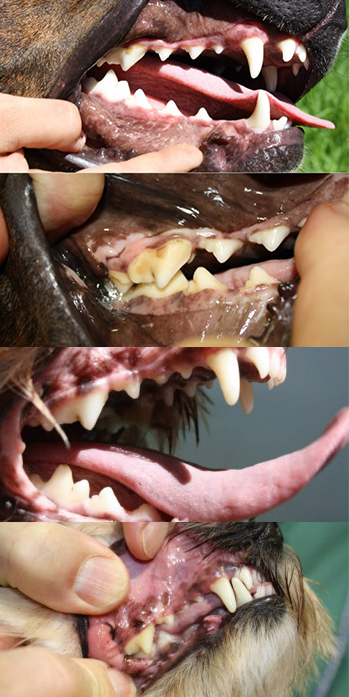 Each photo shows the subject dogs’ teeth while they were eating a raw, species appropriate food, and the stinky breath, yellow teeth, and sore bleeding gums that occurred just 17 days after
Each photo shows the subject dogs’ teeth while they were eating a raw, species appropriate food, and the stinky breath, yellow teeth, and sore bleeding gums that occurred just 17 days after
feeding a veterinary diet. “Because they haven’t been scrubbed away by the appropriate food, the bacteria multiplied,” explains Dr Lonsdale.
“And they’re now gaining access to these dogs’ mouths, and from the mouth to the rest of the body. And that, we think, is the reason why animals end up with many diseases of the liver, the kidneys, the heart, the immune system, and so on.” Dr Fox warns,
“Maintaining pets’ dental hygiene, along with good nutrition – where highly processed and pet food ingredients, especially corn and soy glutens, leave micro-particles adhering to the teeth and foster dental disease – prevents much animal suffering.
Dental problems, closely related to diet, are very common in dogs and cats and are often left untreated for too long, causing much suffering and long crippling, even fatal illness. These include kidney, liver and heart disease secondary to periodontal disease.”
The Conclusion
Dental cleaning under anesthesia has become the norm, given that the vast majority of dogs suffer from dental disease (because the vast majority of dogs are fed kibble and starch-laden diets).
But this only compounds the risk of feeding your dog a processed diet.
In an article entitled Remove Malpractice Risk from Anesthetic Risk published in DVM Newsmagazine, June 1st, 2004, veterinarian and attorney Dr Christopher Allen wrote, “Clients who sue are shocked clients; they sue after they bring in a reasonably healthy looking pet but leave with their animal in a plastic bag. They sue when their high-risk pet dies under anesthesia and no one fully explained the concept of anesthetic risk. A disproportionate number involve pet deaths that have occurred while an animal was sedated or under anesthesia.”
Dr Fox adds,
”Cleaning teeth on a regular basis under general anesthesia is a high-risk money-maker that can mean death for otherwise healthy animals.”
Clearly, Dr Lonsdale’s little experiment should be a wakeup call for pet owners.
Veterinarian Dr Will Falconer agrees:
“Do wolves die toothless? Or live with decayed teeth, tartar encrusted teeth, or yellow teeth? Of course not. How is this possible?”
Perhaps, says Dr Falconer, more importantly the question should be: how did we come to believe all this hype about teeth brushing and dentistry? And what sorts of things have we foisted on the animals that has caused all this dental disease?
“It can only be that this chronic disease has come from our deviating from the wild model, raising our pets in ways that are quite different from that of their ancestors and wild cousins, the wolf and bobcat.”
Veterinarian Sara Chapman concludes, “Raw meaty bone diets keep wild carnivores’ teeth in top condition, and they can do the same for our domesticated carnivores. Even ground raw diets help prevent tartar build up, as the meat contains natural enzymes, and raw diets do not stick to the teeth, unlike diets that are high in starch. Kibble (dry food) has long been touted as helping to keep teeth clean because of its abrasive action. If you have ever watched your dog eat kibble, you have surely noticed that they don’t chew the stuff, they bolt it down whole. I encourage all my clients to feed a balanced, high quality raw diet if possible; balanced high quality cooked or canned diets are acceptable alternatives if they can not feed raw.”
Despite proper diet, some dogs are genetically predisposed to dental disease … especially toy breeds and short-nosed breeds.
Dr Becker offers these other solutions to keep your dog’s mouth healthy and bacteria-free:
- Offer recreational, raw bones. Offering your pet raw knuckle bones to gnaw on can help remove tartar the old fashioned way – by grinding it off through mechanical chewing. There are some rules to offering raw bones (not for pets with pancreatitis, diseases of the mouth, weak or fractured teeth, resource guarders, “gulpers,” etc.) so ask your holistic vet if raw bones would be a good “toothbrush” for your dog. I recommend offering a raw bone about the same size as your pet’s head to prevent tooth fractures.
- If your dog cannot or should not chew recreational raw bones, I recommend you offer a fully digestible, high quality dental dog chew.
- Perform routine mouth inspections. Your pet should allow you to open his mouth, look inside, and feel around for loose teeth or unusual lumps or bumps on the tongue, under the tongue, along the gum line and on the roof of his mouth. After you do this a few times, you’ll become sensitive to any changes that might occur from one inspection to the next. You should also make note of any differences in the smell of your pet’s breath that aren’t diet-related.

